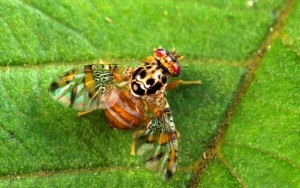
East County News Service
Photo: U.S. Department of Agriculture
August 18, 2015 (La Mesa)-- State, federal and County of San Diego officials have announced that 93 square miles covering portions of San Diego City and East County communities have been put under quarantine after the discovery of four Mediterranean fruit flies — a dangerous pest that can infest more than 250 crops.
Backyard gardeners are being encouraged not to move fruit they grow off their properties, but to eat it at home instead, while commercial growers, nurseries, wholesalers and retailers will have to comply with quarantine requirements.
The California Department of Food and Agriculture, United States Department of Agriculture and the County’s Department of Agriculture, Weights and Measures are working together to eliminate the infestation.
Agencies have already started dropping millions of sterile fruit flies — which have been used successfully to eradicate past infestations — and to treat properties within 650 feet of where the flies were found with a naturally-occurring bacteria that is poisonous to Mediterranean fruit flies.
A neighbor of a home where a fruit fly was found has advised East County Magazine that treatments would be on the ground, not aerial spraying.
The 93-square-mile quarantine area is bordered on the north by Prospect Avenue; on the south by Mount Miguel Road; on the west by Fairmount Avenue; and on the east by Vista Grande Road. Map of quarantine area (PDF)
The Mediterranean fruit fly infests fruits and vegetables — including apples, apricots, avocados, figs, grapes, grapefruit, lemons, limes, nectarines, oranges, peaches, pears and tomatoes — by laying eggs inside that hatch into maggots.
“This invasive fruit fly is considered to be the most harmful agricultural pest in the world,” said County Agriculture Commissioner Ha Dang. “Effective eradication measures help to safeguard the local food supply, fruit export and the environment.”
Officials said the four male flies were detected between July 22 and Aug. 4. Agencies began releasing 15 million sterile fruit flies a week Aug. 10.
County teams helped state crews set more than 1,300 traps in the quarantine area last weekend, they continue to help monitor the infestation and County Geographical Information System teams have provided maps to study the area and infestation.
Quarantines for Mediterranean fruit flies last three life cycles after the last fly was detected. The fruit fly’s life cycle is approximately 30 days.
For more information, call the California Department of Food and Agriculture’s Pest Hotline at (800) 491-1899.







Recent comments